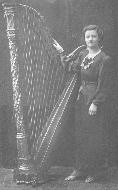|
             
Copyright
Helen Forder
2004
|
|

|
|
At the end of the 18th century
the development of the more sophisticated pedal harp brought a decline in
the popularity of the triple
harp. The difficulty of playing on
the middle row of strings during rapid passages was a drawback, as was the
fact that it was impossible to play in any other key than that in which the
triple harp was tuned.
'... the pedal harp ... is an immense
improvement in a musical sense, upon any former invention, as it admits of the
most rapid modulation into every key, and enables the performer to execute
passages and combinations that would not have been dreamt of previously.' John Thomas, Pencerdd Gwalia, The National Music of Wales, 1878.
|

Sylvia Walters
Telynores Llynfi
|
|
|
Throughout her long life Lady
Llanofer (née Augusta Waddington 1802 - 1896) fought to maintain all
aspects of Welsh culture, which many saw as being under threat during that
period. The language, literature, traditions and music of the Principality
were all of interest to her, but particularly close to her heart was the
plight of the triple harp; she wanted to 'restore
to its proper position the national instrument of the principality, and to
encourage the cultivation of the pure and simple style in which the ancient
Welsh music ought to be played'.
|
|
Augusta was familiar with
the harp, 'the Caerphilly harper' having played at her wedding in 1823; she
herself had lessons with the harpist and pianist Elias Parish - Alvars
(1808 - 1849).
|
|
Augusta Hall attended the
Brecon Eisteddfod of 1826 and heard John Jones playing the triple harp,
when his brilliant performance won him the highest award offered, namely
the silver harp. It was at this same eisteddfod that she met Carnhuanawc (the Rev. Thomas Price) who was also interested in
the harp, and anxious to encourage its use.
|
|
|
Following the completion of
Llys Llanofer in about 1837, Benjamin and Augusta Hall, (later Lord and
Lady Llanofer) installed John Jones as their family harper (a position he
held until his early death in 1844, at the age of 44), and from then on
there was always a harper maintained by them. This was one of Lady
Llanofer's ways of supporting and encouraging the use of the triple harp.
|
|
|
Another way was through the
eisteddfodau of the time. The triple harp was made the official instrument
of the eisteddfodau held by Cymreigyddion Y Fenni, between 1834 and 1853,
and players of the pedal harp were not allowed to take any part in the
proceedings. Harps were given as prizes and as well as donating instruments
herself, she persuaded her wealthy and influential friends to do the same.
She had a staunch ally in Carnhuanawc who was one of the founders of
Cymreigyddion Y Fenni. He too favoured the triple harp and was well aware
of its plight.
|
|
|
1 2 3 4 next
|
|
|
|

